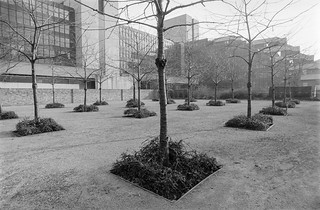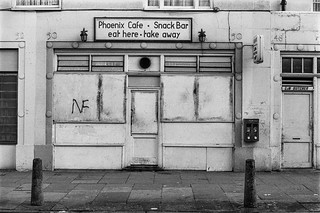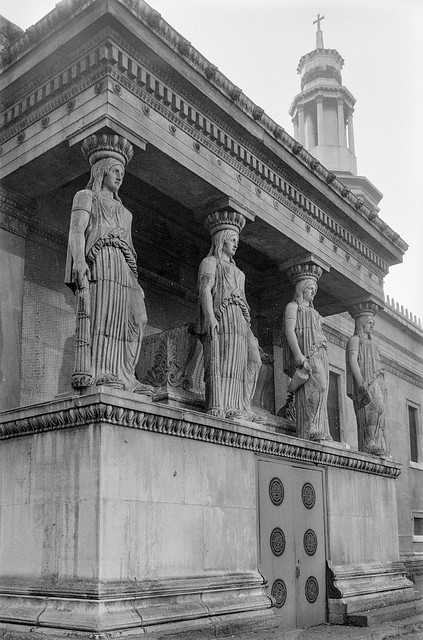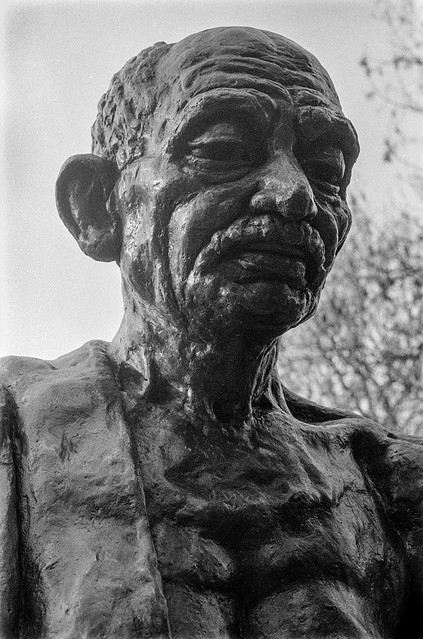This building is a part of a comprehensive redevelopment of the area, the Comyn Ching triangle, by the Terry Farrell Partnership which took place from 1983-1991, retaining the facades with rebuilt or restored shopfronts. This part of the Grade II listed terrace at 65-71 Monmouth St was only rebuilt in the third and final phase of development which began around two years after I made this picture. The lettering ‘B. FLEGG/ ESTd.1847/ SADDLER & HARNESS MAKER/ LARGE/ STOCK /OF/ SECONDHAND SADDLERY & HARNESS/ HORSE/ CLOTHING/18, with the name B. FLEGG applied diagonally to each side’ was then painstakingly restored.
Though sometimes referred to as a ‘ghost sign’, like many others it should more correctly be called a ‘resurrected sign’.
One of the minor themes in my work at this time concerned the urban tree. London is a city with a great many of them, notably those London Planes, a hybrid of American sycamore and Oriental plane which first appeared by cross-pollination of these two introduced species in the Lambeth garden of London’s best known plantsman, John Tradescant the younger, who named it after the city around the middle of the 17th century. It has been widely grown in streets and parks across the city since the late 18th century.
I think these trees in their regimented rows are probably flowering cherries though probably some with greater aboreal knowledge will correct me. But this was a militarised forest that rather made me shudder. The planting was apparently designed to stop students playing football in the area. It hasn’t lasted and there is now a green area here – though some of the trees in it may be these same specimens, and there are still a couple of large brutalist concrete boxes around a couple of groups of trees.
And in the background of the previous image was one of my favourite brutalist buildings, with a playfulness by Denys Lasdun’s that is perhaps more exiting than his National Theatre. It was a part of a larger plan, never completed and much opposed at the time, though in the end it was only a lack of money that really stopped the destruction of more of the area and the building on the open areas such as the ‘garden’ above.
The Ossulston Estate in Somers Town, close to Euston Station was a remarkable council estate built by the London County Council in 1927-31, taking inspiration from modernist public housing which the LCC’s Chief Architect G Topham Forrest had visited in Vienna. The 7-storey housing blocks are behind a low wall of shop units along Chalton St, of which the Phoenix Cafe was one. Some of these units are still in use as shops, though not this one.
The 310 flats were built to high standards for the time and the development also included The Cock Tavern – all are now listed. Some of the estate has been extensively refurbished.
One of my favourite church exteriors in London is that of St Pancras (New) Church in Euston Rd, built in 1819–22 in Greek Revival style to the designs of William Inwood and his son Henry William Inwood. Perhaps its most remarkable feature are these caryatids, who look to me pretty fed up, perhaps unsurprisingly as they have a stone roof sitting on their heads. They are above the entrance to the burial vault and hold symbols suitable to this position, empty jugs and torches which have gone out.
A short distance away in Tavistock Square is a memorial to Mahatma Gandhi, 1869 – 1948, who studied not far away at UCL in 1888. The powerful likeness is by Fredda Brilliant and the site for it was chosen by V K Krishna Menon who was a member of the Theosophical Society and for some years a St Pancras Councillor before being made High Commissioner for India in the UK. The memorial was erected for the 125 anniversary of his birth and unveiled by then Prime Minister Harold Wilson.
Most years for some time I have visited Tavistock Square each August for the annual remembrance on Hiroshima day around the Hiroshima Cherry tree a short distance from this statue. The square also contains a memorial to the victims of the 2005 bombing here, the Conscientious Objectors Commemorative Stone, a memorial and bust of surgeon Dame Louisa Aldrich-Blake (1865 –1925) and a bust of Virginia Woolf.
More pictures on Flickr in the album 1987 London Photos.
Tags: 1987, Bloomsbury, Camden, caryatids, Covent Garden, Gandhi, garden, ghost sign, Institute of education, London, London Photos, Ossulton Estate, Somers Town, St Pancras Church, Tavistock Square, trees, UCL





